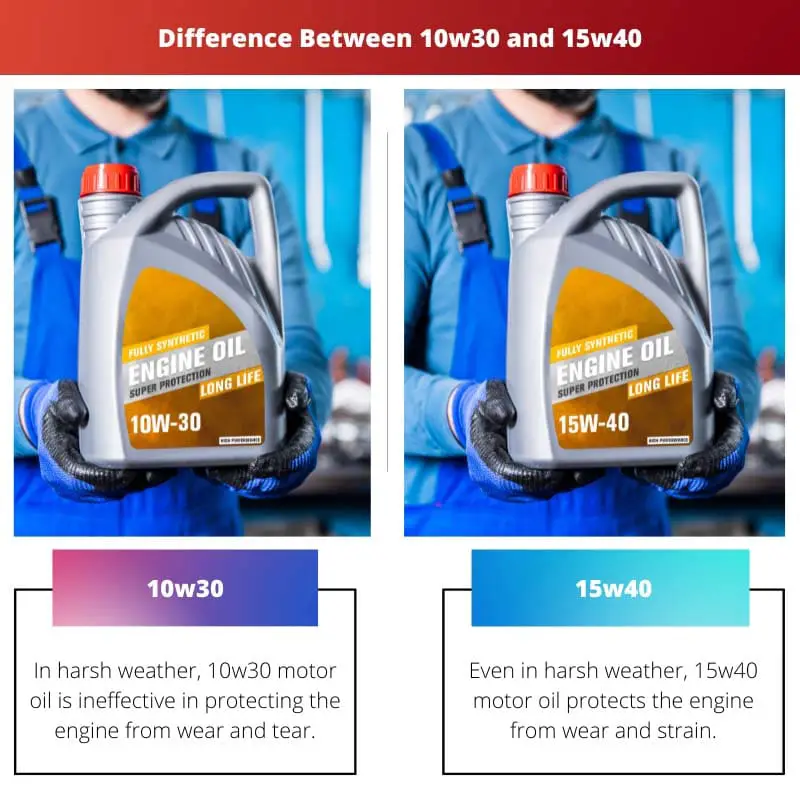When the weather is cold, or the engine temperature is low, the viscosity grade of 10w30 motor oil flows is equivalent to ten-weight oil. Furthermore, when the engine is incredibly hot or at its peak temperature, it can withstand thirty pounds of force.
In cold weather circumstances, 15w40 motor oil has a viscosity similar to fifteen-weight oil. It can also safeguard a forty-pound weight at the engine’s greatest operating temperature.
Key Takeaways
- 10w30 provides better fuel economy and performs well in lower temperatures than 15w40.
- 15w40 offers superior engine protection and operates more effectively in high-temperature environments than 10w30.
- 10w30 is recommended for most gasoline engines, while 15w40 suits diesel engines and heavy-duty applications.
10w30 vs 15w40
The difference between 10w30 and 15w40 is that when the weather is cold or the engine temperature is low, 10w30 motor oil has a viscosity grade that flows like ten-weight oil. It can also withstand thirty pounds when the engine is very hot or at its peak temperature. In cold weather, 15w40 motor oil has a viscosity similar to fifteen-weight oil. It can, however, protect a forty-pound load at the engine’s highest operating temperature.

In harsh weather, 10w30 motor oil is ineffective in protecting the engine from wear and tear. The additives in 10w30 motor oil are of poor grade.
As a result of its thinner consistency, this oil is more prone to oxidation, resulting in poorer film strength. Every time you use 10w30 motor oil, the viscosity is about the same.
The 10w30 motor oil is preferred because it is less volatile, heat resistant, and has a consistent viscosity.
Even in harsh weather, 15w40 motor oil protects the engine from wear and strain. The additives added to the 15w40 motor oil are of very high quality, and they protect the oil from oxidation.
However, this oil has a heavier viscosity than 10w30 motor oil. Every time you use 15w40 motor oil, the viscosity will be different. It has a range of viscosities.
15w40 motor oil is renowned for being more volatile than 10w30, having lower heat resistance, and having a changeable viscosity.
Comparison Table
| Parameters of Comparison | 10w30 | 15w40 |
|---|---|---|
| Consistency | Thinner | Thicker |
| Extreme weather conditions | Efficient | Inefficient |
| Viscosity | Stable | Variable |
| Additives | Low quality | High quality |
| Oxidation | More likely | Less likely |
What is 10w30?
Every time you use 10w30 motor oil, the viscosity value is nearly the same. 10w30 motor oil is preferred because it is less volatile, heat resistant, and has a consistent viscosity.
For engines that have traveled at least 75000 miles, 10w30 motor oil is recommended.
In the case of harsh conditions, 10w30 motor oil is ineffective in protecting the engine from wear and tear. The additives in 10w30 motor oil aren’t of the highest grade.
As a result of its thinner consistency, this oil is more likely to oxidize, resulting in poorer film strength.
When the weather is cold or the engine temperature is low, 10w30 motor oil has a viscosity grade that flows equivalent to ten-weight oil.
It can also withstand thirty pounds when the engine is really hot or at its maximum temperature.

What is 15w40?
The viscosity of 15w40 motor oil varies from time to time. It has a specific spectrum of viscosities. 15w40 motor oil is more volatile, less heat resistant, and has a variable viscosity than 10w30. The 15w40 motor oil is appropriate for engines that have met or beyond the API CJ-4 criteria.
This oil, on the other hand, has a heavier consistency than 10w30 motor oil. Even in the case of extreme weather, 15w40 motor oil is particularly effective in keeping the engine from wear and strain.
The additives added to the 15w40 motor oil are of very high quality, preventing the oil from oxidizing.
In cold weather circumstances, 15w40 motor oil has a viscosity grade that is equivalent to fifteen-weight oil. It can, however, protect a forty-pound weight at the engine’s greatest operating temperature.
Main Differences Between 10w30 and 15w40
- The motor oil of 10w30 possesses a viscosity grade that flows equivalent to ten weight oil when either the weather is cold, or the engine’s temperature is low. Along with that, it can also resist thirty weight when the engine is super hot or is at its highest temperature. On the other hand, The motor oil of 15w40 possesses a viscosity grade that flows equivalent to oil of fifteen weight in cold weather conditions. However, at the engine’s highest temperature of operation, it can also protect a forty weight.
- The motor oil of 10w30 is inefficient in protecting the engine from wear and tear in the case of extreme cases of weather. On the other hand, the motor oil of 15w40 is highly effective in protecting wears and tear to the engine even in the case of extreme conditions of weather.
- The additives added to the 10w30 motor oil are not of very high quality. Thus, this oil is more likely to undergo oxidation because of its thinner consistency which results in weaker film strength. On the other hand, the additives which are added to the 15w40 motor oil possess a very high quality, which protects the oil from undergoing oxidation. However, the consistency of this oil is comparatively thicker than 10w30 motor oil.
- 10w30 motor oil possesses almost the same value of viscosity every time. On the other hand, 15w40 motor oil possesses a variable value of viscosity every time. It possesses a certain range of viscosities.
- 10w30 motor oil is popular due to its characteristic of being less volatile, resistant to heat, and stable viscosity. On the other hand, 15w40 motor oil is known for being more volatile, less heat resistant than 10w30, and has variable viscosity.
- The motor oil of 10w30 works best for those engines which have covered at least 75000 miles. On the other hand, the motor oil of 15w40 works best for those engines which have met or exceeded the requirements of API CJ-4.

- https://www.sciencedirect.com/science/article/pii/0048969789900491
- https://www.sciencedirect.com/science/article/pii/S0043164801008602
